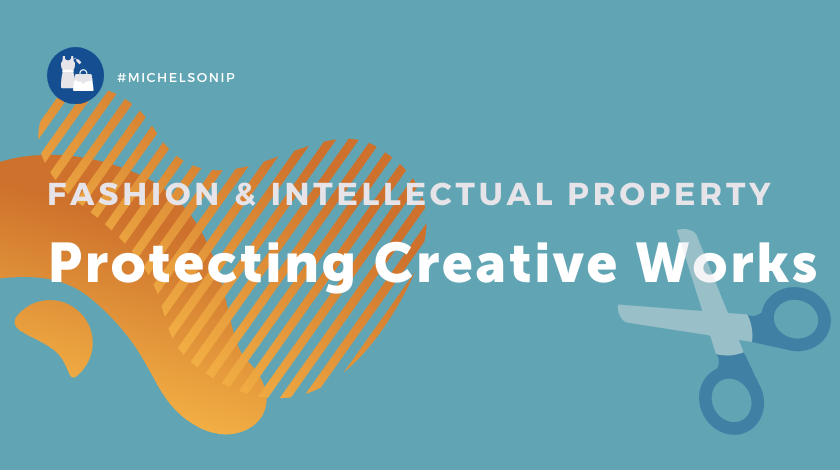By: Dani N. Cohen, Fellow, The Michelson Institute for Intellectual Property
Fashion and Intellectual Property
“Fashion goes with the feeling of the moment. It’s related to movies, to art, to young people’s taste.” – Gianni Versace
This statement from the late prolific designer Gianni Versace is as relevant as it ever was. Fashion has always been a means of presenting artistic ideas, feelings, and self-expression, with bursts of creativity driving new trends and looks. Creativity can lead to questions regarding protection of intellectual property rights, particularly designs and products. What options and legal avenues are available to individuals who seek to protect their creations?
Trademarks in Fashion
Trademarks, a type of intellectual property, protect a brand name or service mark. One example where trademarks are important in fashion is the “pret-a-porter,” or ready to wear market. Consumers usually identify these items by the name of the designer, such as Gucci or Dior. Designers seek trademarks for these names and products because consumers purchase them for the name and quality associated with them. Consumers who want products with the Gucci “interlocking G” logo want to buy Gucci, not Guess products.
This was, in fact, a real trademark infringement case. Gucci filed suit against Guess (the company famous for “those” jeans), and alleged it had infringed upon many of Gucci’s logos and marks, including the “stylized G” mark and the “Repeating GG Pattern.” Gucci prevailed in this case, although they only received $4.7 million in damages. They had originally asked for over $200 million.
Louboutin vs. Yves St. Laurent (YSL)
Another case that reflects the power of trademarks is Louboutin vs. Yves St. Laurent (YSL). YSL had created shoes with red soles, much like the famous “red bottoms” of Louboutins. Here, the issue was whether Louboutin could trademark the red soles. This case went to the US Court of Appeals for the Second Circuit, which granted Louboutin the ability to do so. This is because the shoes had acquired a “secondary meaning.”
The court ruled a designer may be able to protect certain distinctive aspects of designs through establishing a secondary meaning, with color being one way to accomplish this. A secondary meaning means the mark has acquired a certain distinctiveness within the minds of consumers. Louboutins certainly meet that test. The color associated with Tiffany is another example of this. The robin egg blue shade is so closely associated with the iconic jeweler that it too established a secondary meaning and the ability to be trademarked.
Copyright in Fashion
Copyrights are another form of intellectual property protection. They are “granted by law for original works of authorship fixed in a tangible medium of expression. Copyright covers both published and unpublished works.”
A fashion designer who creates sketches obtains copyright protection for the sketch itself the moment it is created and “fixed in a tangible form.” However, this does not always equate to 100% protection, because the underlying idea is not protected. Copyrights can’t protect “intangible” thoughts. (There may be other ways to protect the ideas in the sketch, which will be discussed under design patents.)
Copyright Eligibility (Star Athletica vs. Varsity Brands)
Can you copyright a particular component of a design? This has been explored in the case Star Athletica vs. Varsity Brands. Varsity designed clothing for athletics, particularly cheerleading. These designs included elements such as shapes, colors, and characteristics that did not deal with functionality. Varsity received copyright protection for these elements, and sued Star Athletica, who had similar elements on their products. Star claimed Varsity could not obtain copyright protection because the designs were for “useful articles.” This means the design had an “intrinsic utilitarian” function and didn’t have a particular use in conveying information. The question before the courts was whether the elements in question could be separated from the aspect they were originally used for. In this case, it was as part of the cheerleading uniform. Could they stand on their own in addition to their “usefulness?”
Supreme Court Ruling
The case went to the Supreme Court, which found in favor of Varsity. In doing so, they created a test to determine the copyrightability of “useful article” elements of a design:
“A feature incorporated into the design of a useful article is eligible for copyright protection only if the feature:
- can be perceived as a two- or three-dimensional work of art separate from the useful article, and
- would qualify as a protectable pictorial, graphic, or sculptural work—either on its own or fixed in some other tangible medium of expression—if it were imagined separately from the useful article into which it is incorporated.”
This case is important because it provides a test to support the ability to copyright fashion design elements. Although ambiguous, this means progress for designers. However, there’s a mixed reaction. Some see having the ability to copyright as important to protecting designs. Others see it as a roadblock to “fast fashion,” in which companies mass-market less expensive designs to the public.
Fashion and Intellectual Property Loopholes
Loopholes in copyright laws in the US allow for fast fashion brands, such as Forever 21, Fashion Nova, and Urban Outfitters to profit, legally, on garments that look identical to designs created by higher-end brands. According to WIPO Magazine, in contrast “the European Union has registered and unregistered Community design rights that provide protection for garments and accessories as a whole. That simply does not exist in the United States.” Fast fashion business models rely on the ability to quickly recreate luxury trends and celebrity looks at an affordable price point, and often get away with copying other designers without facing legal consequences.
Diane von Furstenberg, an advocate of increased intellectual protection in the fashion industry, has filed many lawsuits over the years to protect her brand. Specifically, she has filed copyright infringement cases against Forever 21, Target, and Mango, accusing all three companies of reproducing and profiting from dresses that are nearly identical to DVF designs. DVF is one of many vocal fashion designers that have fallen victim to the cheap knockoff. They’re now pushing for increased copyright protection. Furthermore, due to IP law differences, designers in the US must rely more on design patent protection than on copyright.
Design and Utility Patents in Fashion
As stated above, patents are another way for designers to protect their works. A patent for an invention “is the grant of a property right to the inventor, issued by the USPTO.” Two types of patents may prove useful to a fashion designer:
- Utility patent: This type of patent may be granted to anyone who invents a new and useful process, machine article of manufacture, or composition of matter, or any new and useful improvement thereof. This type of patent can be tricky because you must prove that the new invention is a functional technology, and not merely aesthetic.
- Design patent: This type of patent may be granted to anyone who invents a new, original, and ornamental design for an article of manufacture.
A quick way to determine which type of patent to consider is asking the question of whether you are seeking to protect “how it looks,” (design) or “how it works” (utility).
Fashion and Intellectual Property Patent Examples
Levi Strauss’s “Improvement in fastening pocket-openings” provides an example of a utility patent. This patent improved the way riveted pockets fasten. It also gave the company an edge on ownership of this particular fashion element. Another example of a successful utility patent that covers new functionalities for clothing is Uniqlo’s Heat Tech fabrics, which includes technology with new functions.
Design patents, as mentioned above, must be new and ornamental. In other words, the item should be novel and not simply something functional. Some items that have received design patent protection include a Jimmy Choo “Twist” shoe design, as well as a Valentino tote bag from its “Rockstud” line. These items have unique ornamental characteristics and are not simply functional items with little aesthetic value.
It’s a good idea to consider protecting valuable fashion creations and designs when feasible. Intellectual property laws give designers several options to protect their creative works.
Got more IP-related fashion design/business questions that need answers? Register for our free upcoming Ask Me Anything about IP – Fashion Edition virtual event co-hosted with the MPS Fashion Management Program at Parson School of Design.
—
Disclaimer: Nothing in this article shall be construed as legal advice, or as creating an attorney/client relationship.
Download the Free Infographic Below
_________
The Michelson Institute for Intellectual Property, an initiative of the Michelson 20MM Foundation, provides access to empowering IP education for budding inventors and entrepreneurs. Michelson 20MM was founded thanks to the generous support of renowned spinal surgeon Dr. Gary K. Michelson and Alya Michelson. To learn more, visit 20mm.org.

